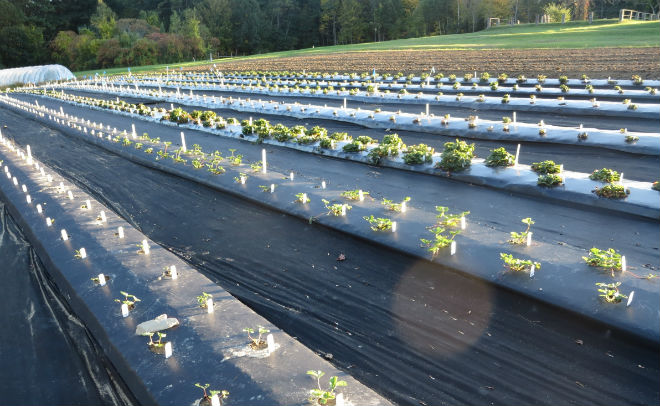Plasticulture strawberries are blooming now across Delaware, Maryland and Virginia. Plasticulture strawberries should have had nitrogen applications prior to bloom.
Base recommendations are 25 lbs/a of N at green-up and another 25 lbs/a of N 2-3 weeks later. If fertigating weekly, addition of 3-5 lbs of nitrogen per acre per week may be warranted. Nitrogen is critical prior to and during early bloom. Including potassium at a 1:1 ratio with nitrogen will often improve fruit quality (sugars).
You can monitor petiole sap N and K concentration in the field. This is based on sampling leaf petioles from the most recently expanded leaves, extracting the sap, and using portable nitrate and potassium meters. The procedure can be found at this website, along with recommended levels for different growth stages. Targets initially are 600-800 ppm petiole sap nitrate and 3000-3500 ppm petiole sap potassium.
While this is a quick way to monitor nutrient levels, growers are also encouraged to take petiole and leaf tissue samples for laboratory analysis. To collect and submit strawberry tissue samples, follow these guidelines: Select the most recently mature, healthy, trifoliate leaves from uniform field areas and the same variety; detach the petioles from the leaves as you collect them and save each separately; include leaves and petioles from 20 to 25 plants; and then submit leaves and petioles together as one sample.
There are a number of laboratories in the region that can run these tissue samples. Leaf tissue nutrient levels should be maintained as follows: N (%) 3–4, P (%) 0.2–0.4, K (%) 1.1–2.5, Ca (%) 0.5–1.5, Mg (%) 0.25–0.45. When in full bloom, petiole tissue nitrate content should be between 4000-6000 ppm and then will decrease thereafter. The recommended levels for petiole tissue nitrate from laboratory analyses can be found at this publication from North Carolina (our week one would be beginning bloom).
Day neutral varieties that fruit into July should maintain higher levels of petiole tissue nitrate later in the season than June bearing types.
– Gordon Johnson, Extension Vegetable & Fruit Specialist, University of Delaware















